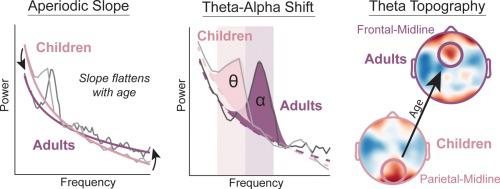Developmental Cognitive Neuroscience ( IF 4.6 ) Pub Date : 2021-05-31 , DOI: 10.1016/j.dcn.2021.100969 Dillan Cellier 1 , Justin Riddle 2 , Isaac Petersen 1 , Kai Hwang 1

|
Intrinsic, unconstrained neural activity exhibits rich spatial, temporal, and spectral organization that undergoes continuous refinement from childhood through adolescence. The goal of this study was to investigate the development of theta (4−8 Hertz) and alpha (8−12 Hertz) oscillations from early childhood to adulthood (years 3–24), as these oscillations play a fundamental role in cognitive function. We analyzed eyes-open, resting-state EEG data from 96 participants to estimate genuine oscillations separately from the aperiodic (1/f) signal. We examined age-related differences in the aperiodic signal (slope and offset), as well as the peak frequency and power of the dominant posterior oscillation. For the aperiodic signal, we found that both the aperiodic slope and offset decreased with age. For the dominant oscillation, we found that peak frequency, but not power, increased with age. Critically, early childhood (ages 3–7) was characterized by a dominance of theta oscillations in posterior electrodes, whereas peak frequency of the dominant oscillation in the alpha range increased between ages 7 and 24. Furthermore, theta oscillations displayed a topographical transition from dominance in posterior electrodes in early childhood to anterior electrodes in adulthood. Our results provide a quantitative description of the development of theta and alpha oscillations.
中文翻译:

3 至 24 岁期间 theta 和 alpha 神经振荡的发展
内在的、不受约束的神经活动表现出丰富的空间、时间和光谱组织,从童年到青春期经历不断的完善。本研究的目的是调查从幼儿期到成年(3-24 岁)的 θ(4−8 赫兹)和 α(8−12 赫兹)振荡的发展,因为这些振荡在认知功能中发挥着基础作用。我们分析了 96 名参与者的睁眼静息态脑电图数据,以独立于非周期 (1/ f ) 信号来估计真正的振荡。我们检查了非周期性信号(斜率和偏移)与年龄相关的差异,以及主要后振荡的峰值频率和功率。对于非周期性信号,我们发现非周期性斜率和偏移量都随着年龄的增长而减小。对于主导振荡,我们发现峰值频率(而不是功率)随着年龄的增长而增加。重要的是,幼儿期(3-7 岁)的特点是后电极中 θ 振荡占主导地位,而 α 范围内主导振荡的峰值频率在 7 岁至 24 岁之间增加。此外,θ 振荡显示出从主导地位到地形的转变。幼儿期的后电极到成年期的前电极。我们的结果提供了 theta 和 alpha 振荡发展的定量描述。











































 京公网安备 11010802027423号
京公网安备 11010802027423号